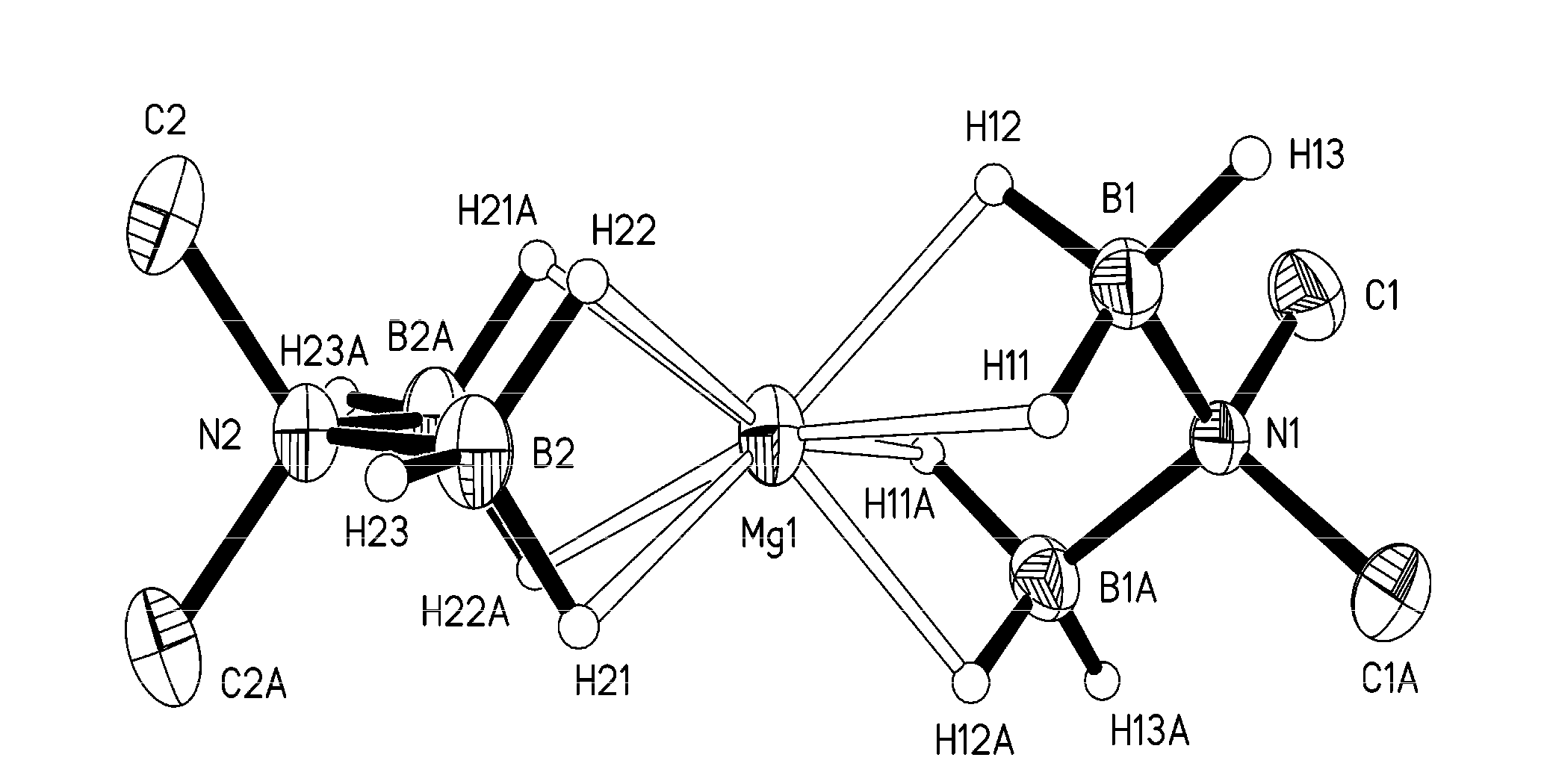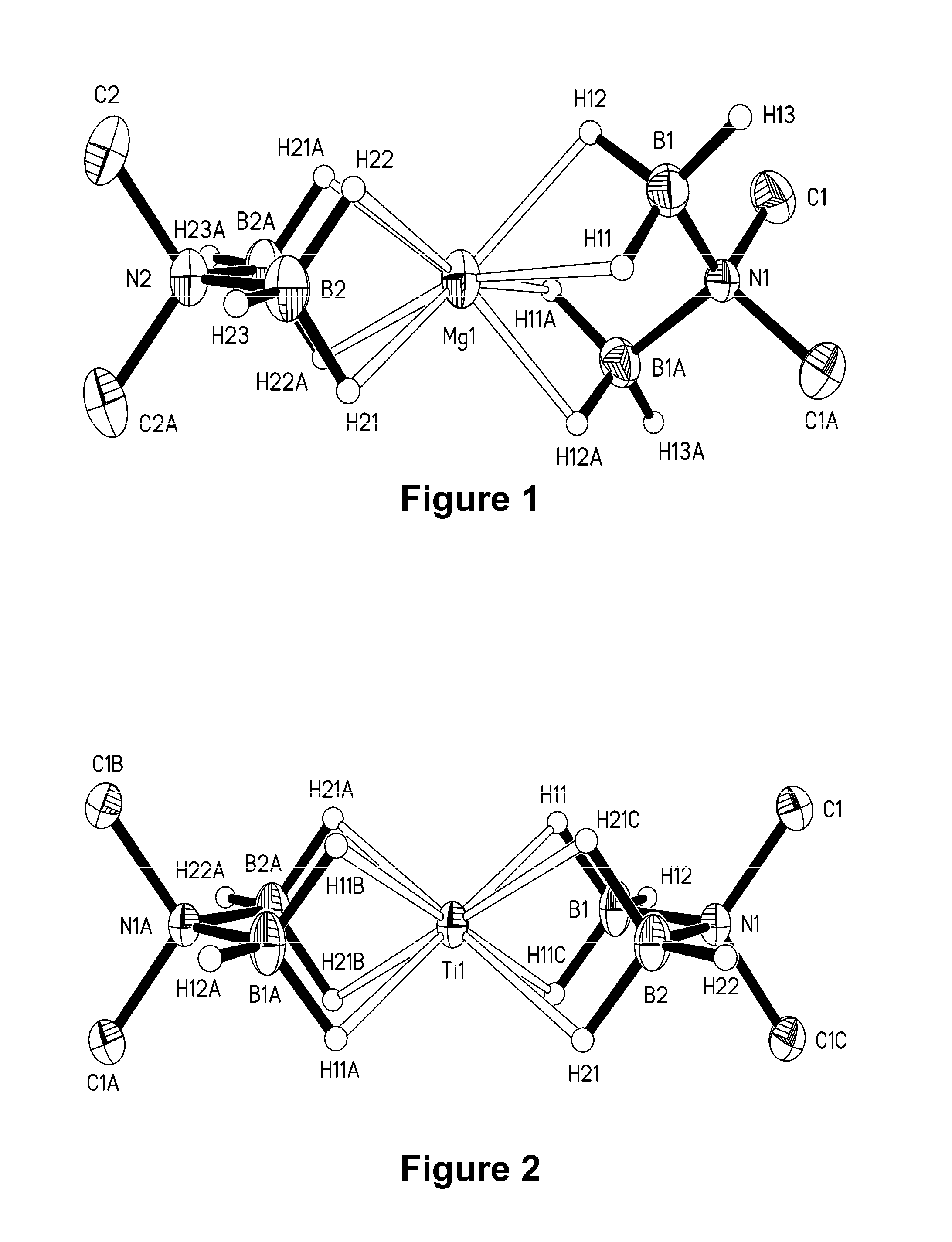Metal Complex Compositions and Methods for Making Metal-Containing Films
a metal-containing film and complex composition technology, applied in chemical vapor deposition coating, group 3/13 element organic compounds, group 5/15 element organic compounds, etc., can solve the problems of difficult pvd methods, film with less useful properties, and high deposition temperature of 720° c., and achieve high melting point, good mechanical hardness, and large thermal and electrical conductivity
- Summary
- Abstract
- Description
- Claims
- Application Information
AI Technical Summary
Problems solved by technology
Method used
Image
Examples
example 1
Synthesis of bis(N,N-dimethyldiboranamido) magnesium(II), Mg(H3BNMe2BH3)2
[0141]MgBr2 powder (1.94 g, 10.5 mmol) and sodium dimethyldiboranamide (2.0 g, 21.0 mmol) were combined and mixed with the use of a mortar and pestle. The ground reaction mixture was transferred in a 100 round-bottom Schlenk flask. The Schlenk flask was capped with a water-cooled cold finger and evacuated. Sublimation under static vacuum afforded colorless product over 8 hours.
[0142]Yield: 1.13 g (64%). Sublimation: 20-70° C. at 0.05 Torr. Vapor pressure at 20° C.: 0.8±0.1 torr. Mp: 70° C. 1H NMR(C7D8, 20° C.): δ 2.04 (s, 12H, NMe2), 1.91 (q, JBH=90.0 Hz, 12H, BH3). 13C{1H} NMR(C7D8, 20° C.): δ 50.98 (s, NMe2). Anal. Calcd for C4H24N2B4Mg: C, 28.6; H, 14.4; N, 16.6; B, 25.8; Mg, 14.5. Found: C, 28.6; H, 15.1; N, 16.6, B, 25.7; Mg, 14.1.
[0143]The molecular structure of Mg(H3BNMe2BH3)2, which was determined by single crystal X-ray crystallography, is shown in FIG. 1. Mg(H3BNMe2BH3)2 is a monomeric compound in wh...
example 2
Synthesis of bis(N,N-dimethyldiboranamido)(tetrahydrofuran)magnesium(II), Mg(H3BNMe2BH3)2(thf)
[0144]To a suspension of MgBr2 (0.51 g, 2.8 mmol) in thf (20 ml) at room temperature was added a solution of Na(H3BNMe2BH3) (0.53 g, 5.6 mmol) in thf (30 ml). After the reaction mixture had been stirred for 8 h at room temperature, the solvent was removed in vacuum. Colorless solid was isolated as a product by sublimation.
[0145]Yield: 0.31 g (47%). Sublimation: 70° C. at 0.05 Torr. 1H NMR(C7D8, 20° C.): δ 3.57 (m, 4H, OCH2), 2.33 (s, 12H, NMe2), 1.99 (q, JBH=84.5 Hz, 12H, BH3), 1.28 (m, 4H, OCH2CH2). 13C{1H} NMR(C7D8, 20° C.): δ 69.2 (s, OCH2), 52.4 (s, NCH3), 25.5 (s, OCH2CH2). Anal. Calcd for C8H32N2B4OMg: C, 40.1; H, 13.4; N, 11.7; B, 18.0; Mg, 10.1.
[0146]Found: C, 39.5; H, 13.3; N, 11.3; B, 16.0; Mg, 10.5.
example 3
Synthesis of bis(N,N-dimethyldiboranamido)(1,2-dimethoxyethane)magnesium(II), Mg(H3BNMe2BH3)2(dme)
[0147]The synthesis of this compound is similar to that of Mg(H3BNMe2BH3)2(thf) in Example 2, using 1,2-dimethoxyethane instead of thf. Colorless crystals were obtained by sublimation.
[0148]Yield: 0.27 g (37%). Sublimation: 80° C. at 0.05 Torr. 1H NMR(C6D6, 20° C.): δ 3.00 (s, 6H, OMe), 2.81 (s, 4H, OCH2), 2.48 (s, 12H, NMe2), 2.11 (q, JBH=88.5 Hz, 12H, BH3). 13C{1H} NMR(C6D6, 20° C.): δ 69.6 (s, OCH2), 59.6 (s, OCH3), 52.6 (s, NMe2). Anal. Calcd for C8H34N2B4O2Mg: C, 37.3; H, 13.3; N, 10.9; B, 16.8; Mg, 9.42.
[0149]Found: C, 36.4; H, 13.2; N, 10.4; B, 17.1; Mg, 9.92.
PUM
| Property | Measurement | Unit |
|---|---|---|
| melting points | aaaaa | aaaaa |
| temperature | aaaaa | aaaaa |
| critical temperature Tc | aaaaa | aaaaa |
Abstract
Description
Claims
Application Information
 Login to View More
Login to View More - R&D
- Intellectual Property
- Life Sciences
- Materials
- Tech Scout
- Unparalleled Data Quality
- Higher Quality Content
- 60% Fewer Hallucinations
Browse by: Latest US Patents, China's latest patents, Technical Efficacy Thesaurus, Application Domain, Technology Topic, Popular Technical Reports.
© 2025 PatSnap. All rights reserved.Legal|Privacy policy|Modern Slavery Act Transparency Statement|Sitemap|About US| Contact US: help@patsnap.com



